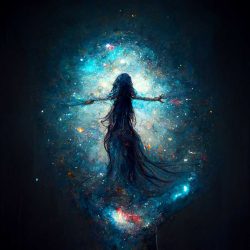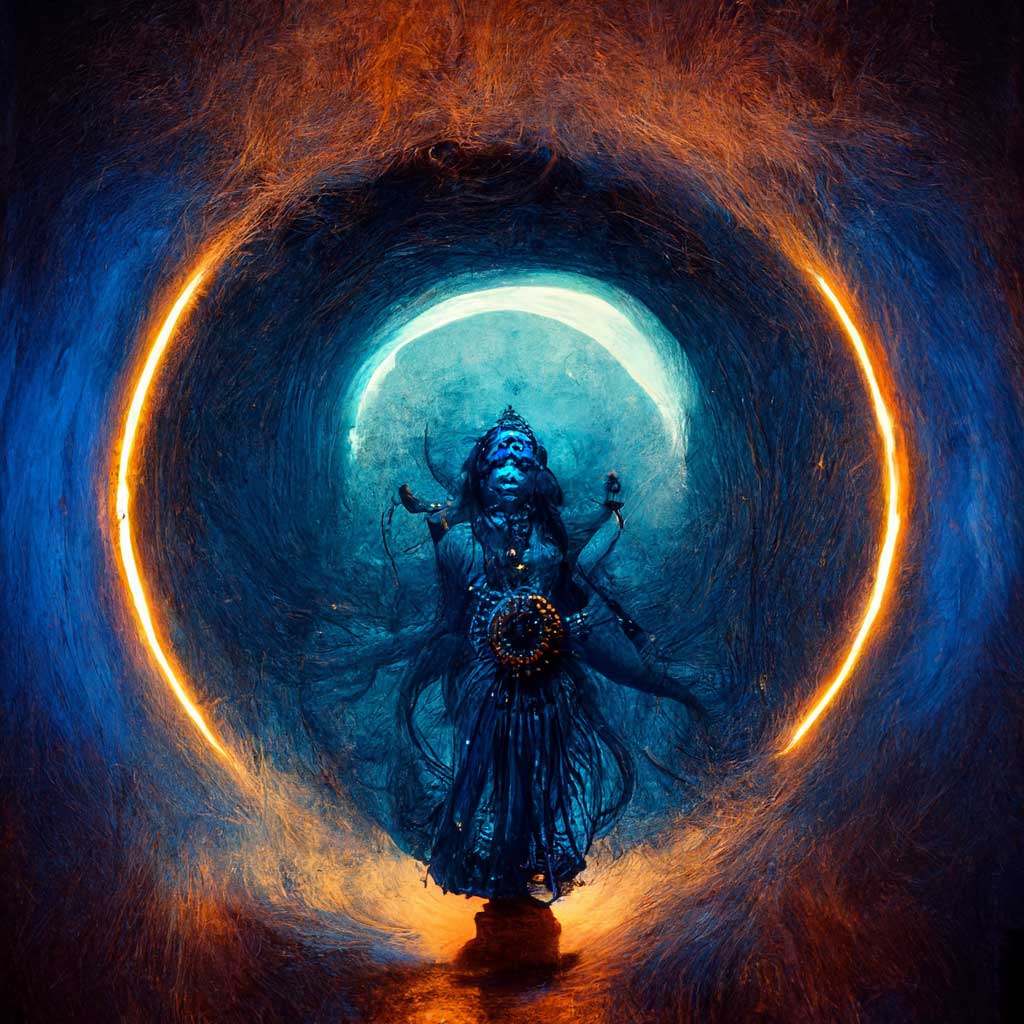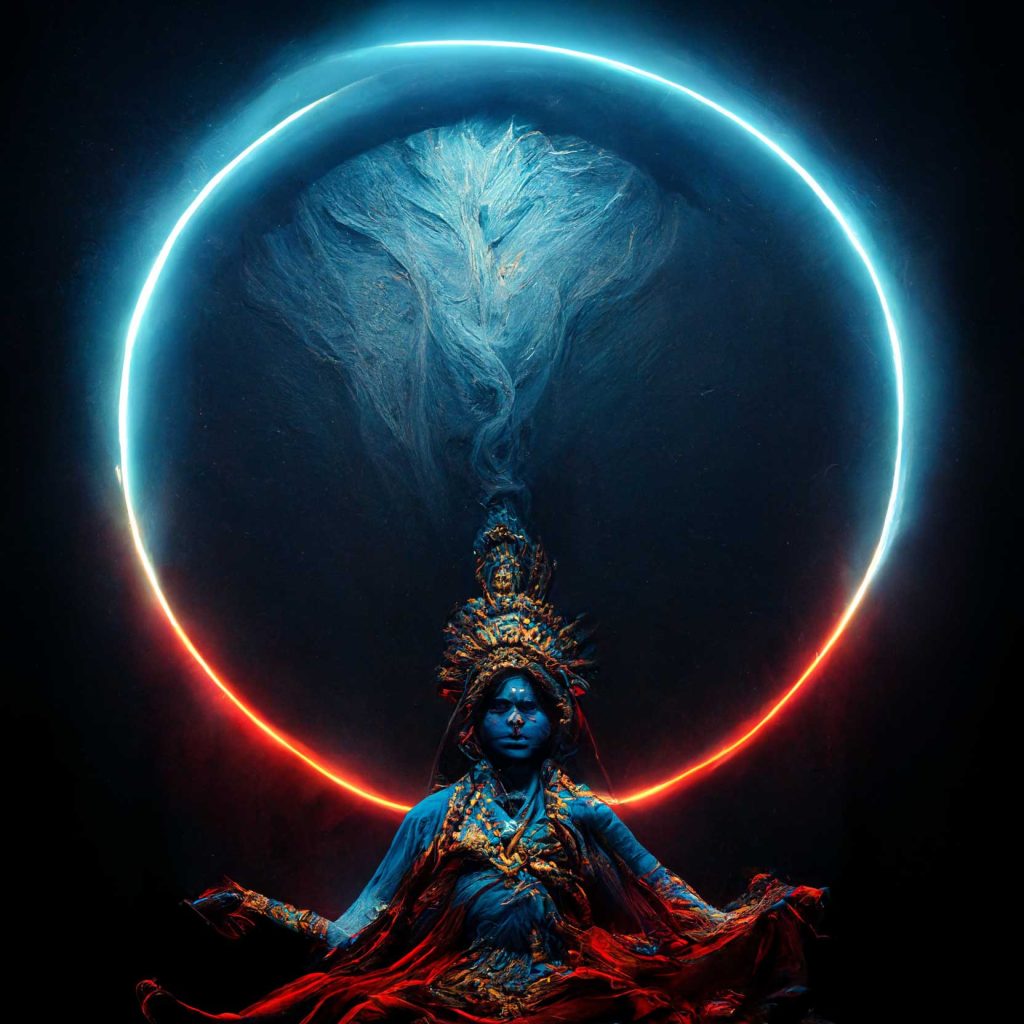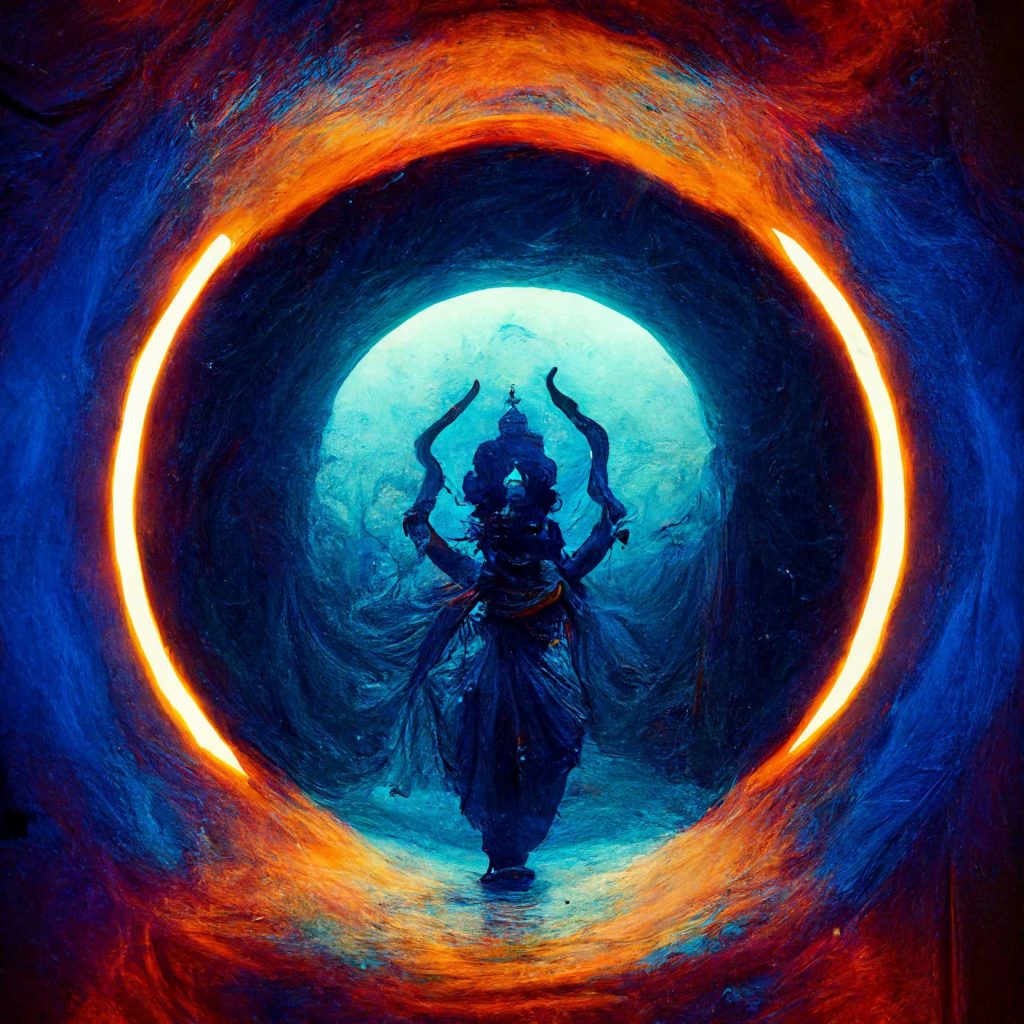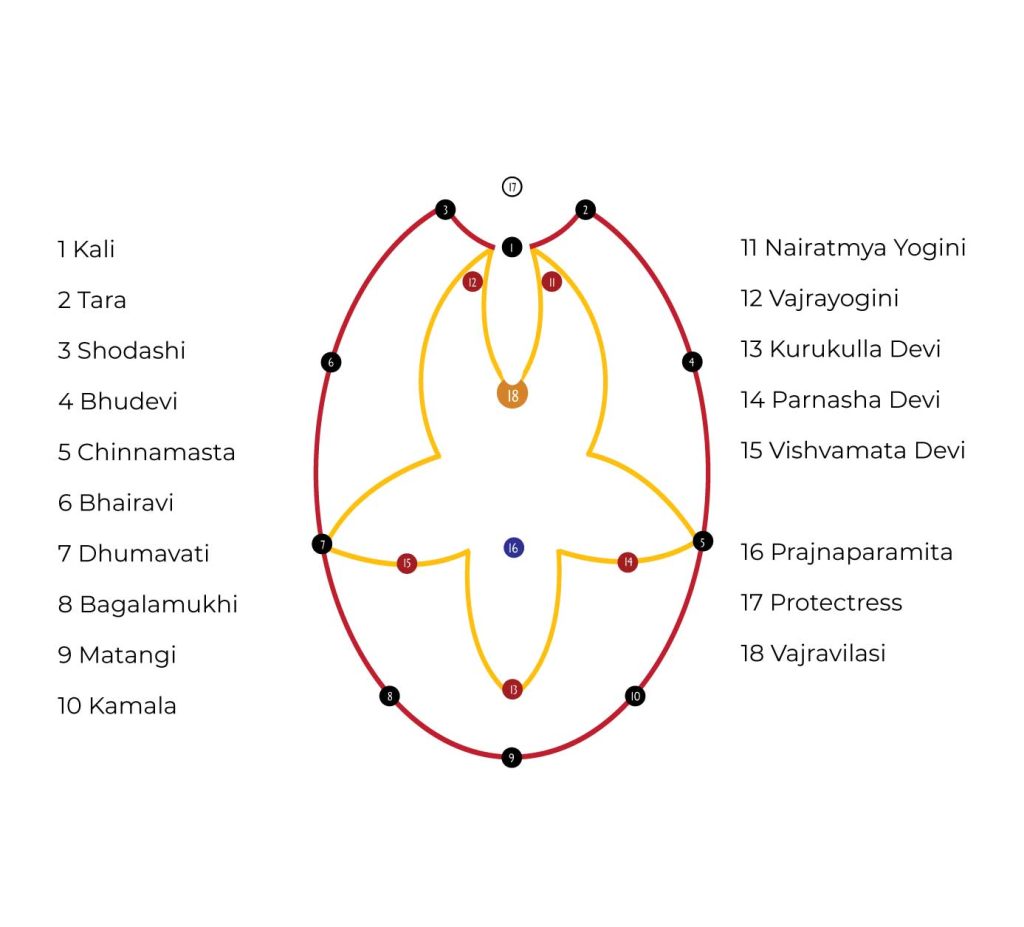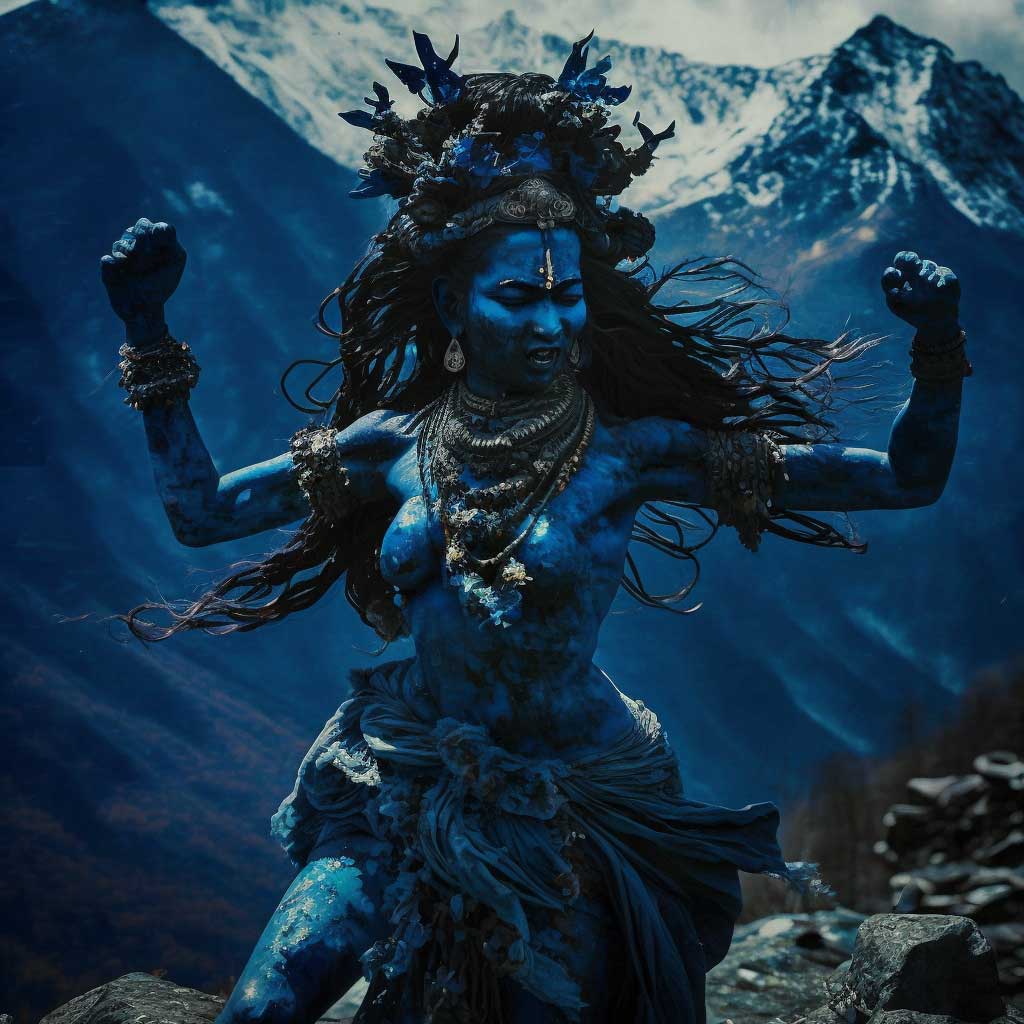
Kali Ma the Adi Mahavidya - She is the Black Goddess
She is the terrible one who has a dreadful face. Her hair is disheveled and she wears a garland of freshly cut human heads. Her ear ornaments are the corpses of children. Her fangs are dreadful, and her face is fierce. Her breasts are large and round, and she wears a girdle made of severed human hands. Blood trickles from the corners of her mouth and makes her face gleam. She makes a terrible sound and lives in the cremation ground, where she is surrounded by howling jackals.
Kali is completely naked. Her body gleams with blood. The blood smeared all over her body is from the garland of bleeding severed heads around her neck. She has four arms. In her upper left hand, she holds a sword that has been bloodied by the severed head that she holds in her lower left hand.
Her upper right hand makes the gesture of assurance and her lower right hand is the sign of granting favors. She stands on the chest of Siva in the form of a corpse. She is eager to have sexual intercourse in reverse fashion with Mahakala. She has a bluish complexion and is lustrous like a dark cloud. She wears a satisfied expression. Her tongue lolls. She smiles.
Early History of Kali
The earliest references to Kali date to the medieval period (around 600 ce). They usually place her on the periphery of Hindu society or the battlefield. Original texts (Puranas) involve Kali for success in war and victory over one’s enemies.
She has an awful appearance: she is gaunt, has fangs, laughs, and dances madly. She wears a garland of corpses, sits on the back of a ghost, and lives in the cremation ground.
She is asked to crush, trample, break, and burn the enemy. Kali’s association with thieves is also seen in her role as the patron deity of the infamous Thugs. The Thugs specialized in befriending and then murdering travelers. She is also known to bestow magical powers on thieves to help them in their criminal deeds.
Kali’s association with the periphery of Hindu society (she is worshiped by criminals, tribals, and members of low castes in uncivilized and wild places) is also evident in the architecture work of the 6th-8th centuries. Her association with criminals reinforces her dangerous role in society. She is at home outside the moral order and seems to be unrestrained by it.
In terms of her early history, it is evident Kali is a goddess who threatens stability and order. Although she may be said to serve an order in her role as the slayer of demons, more often than not she becomes so frenzied on the battlefield, intoxicated on the blood of her victims, that she begins to destroy the world that she is supposed to protect. Thus, even in the service of gods, she is dangerous and likely to get out of control.
In association with other goddesses, she emerges to represent their embodied wrath and fury, a frightening, dangerous dimension of the divine feminine that is released when these goddesses become enraged or are summoned to take part in war and killing.
Kali and Tantrism
Despite Kali’s terrible appearance, gruesome habits, and association with the periphery of civilization in many early references, she achieved great popularity and prominence in the Hindu tradition.
She figures prominently in tantric texts in Kashmir. Specifically, the philosophy that portrays reality as the interaction of two principles, Siva and Sakti, Kali is often designated as one of the forms assumed by Sakti.
So it is clear that tantric sadhana (spiritual endeavor) featuring Kali was common in Kashmir at an early period. An important image in Kashmir Tantrism is the sakti cakra, described as a wheel of energy symbolizing the evolution and dynamics of consciousness. Sometimes the main wheel has additional wheels within it, representing different types of consciousness, or phases in the cognitive process, and those wheels are identified with ‘the twelve Kali’s’.
An underlying assumption in tantric ideology is that reality is the result and expression of the symbolic interaction of male and female, Siva and Sakti, the quiescent and the dynamic, and other opposites that produce creative tension. Consequently, goddesses in Tantrism play an important role and are affirmed to be crucial in discerning the nature of ultimate reality.
Although Siva is usually said to be the source of the tantras, the source of wisdom and truth, and Parvati, his spouse, to be the student to whom the texts are given, many of the tantras emphasize the fact that it is Sakti (personified as Parvati, Kali, and other goddesses) who is immediately present to the adept. For the tantric adept it is her vitality that is sought through various techniques aimed at the spiritual transformation; therefore it is she who is affirmed as the dominant and primary reality.
The Primordial Mahavidya
The Mahavidyas are a group of ten goddesses. They arose in the subconscious in the early medieval period (post-10th century). Kali is the primordial Mahavidya.
In some cases, it seems apparent that the other Mahavidyas originate from Kali or her differing forms. Kali lends to the group as a whole her characteristics. Her character, attributes, and nature are reflected by the other Mahavidyas.
Kali reveals or symbolizes the ultimate goal suggested or implied in the other ten Mahavidyas. Kali alone among the Mahavidyas, or to the fullest extent, reveals the nature of ultimate reality and symbolizes fully awakened consciousness.
In several of their origin myths, the Mahavidya arise when a goddess (Sati, Parvati, or Kali) exerts her independence from her husband, invariably Siva. In this case, the Mahavidyas are symbols of female independence. Kali dramatically illustrates this.
She is rarely if ever, depicted as playing the role of the compliant, subservient wife. She is not characterized by the attributes of a woman devoted to her husband, obedient to his wishes, and compliant to his will in every way.
As Siva’s consort, she violates that stereotype. She dominates him, inciting him to a destructive frenzy, standing on his body, or assuming the upper position, the ‘mans position’, in sex.
Kali is sexually powerful. In later texts, she is often said to be eternally young, with full and firm breasts, and a beautiful smiling face. In later tantric texts, she is sexually aggressive and is often shown or described as having sex with Siva.
She has many names: She Whose Essential Form is Sexual Desire, Whose Form is the Yoni, Who Loves the Lingam. In this respect, Kali also violates the idea of the controlled woman who is sexually satisfied by marriage. Kali is sexually voracious and dangerous because of this.
Kali denotes freedom, particularly freedom from social norms. She dwells outside the confines of normal society. She prefers the cremation ground, which is a place avoided by those who live within society. She lives in the forests or the jungle, among uncivilized people. Her loose hair and nudity suggest that she is unrestrained from social and ethical roles and expectations.
She is worshiped by criminals and outcasts. She is unrefined, raw in appearance and habit. She is powerful and full of energy. She is an outsider, a breaker of boundaries and social models.
Kali's Potent Symbolism
Kali’s four arms represent the complete circle of creation and destruction that is contained within or encompassed by her. She represents the inherent creative and destructive rhythms of the cosmos.
Her right hands, making the mudras of ‘fear not’ and conferring boons, represent the creative aspect of Kali, while her left hands, holding a bloodied sword and a severed head, represent her destructive aspect. Her three eyes represent the sun, moon, and fire, with which she can observe the three modes of time: past, present, and future.
The bloodied sword and severed head also symbolize the destruction of ignorance and the dawning of knowledge. The sword is the sword of knowledge that cuts the knots of ignorance and destroys false consciousness (the severed head). Kali opens the gates of freedom with this sword, having cut the eight bonds that bind human beings.
Kali’s lolling tongue and sharp fangs symbolize the conquest of rajasic power (physical, sensory, red tongue) by sattvic power (spiritual, white teeth). Kali is sattvic, spiritual in nature, having transcended all impurities.
Kali’s blackness symbolizes her all-embracing, comprehensive nature because black is the color in which all other colors merge; black absorbs and dissolves them and symbolizes transcendence of all forms.
Kali’s nudity has a similar meaning. It symbolizes that she is completely beyond name and form, completely beyond the illusory effects of maya (false consciousness), and completely transcendent illuminated consciousness. Kali is the bright fire of truth which cannot be hidden by the clothes of ignorance. Such truth burns them away.
Kali’s dwelling place, the cremation ground, has a similar meaning. The cremation ground denotes a place where the five elements are dissolved. Kali dwells where dissolution takes place.
In terms of devotion, worship, and sadhana, this denotes the dissolving of attachments, anger, lust, and other binding emotions, feelings, and ideas. The heart of the devotee is where this burning takes place, and it is in the heart that Kali dwells. The devotee makes her image in his heart and under her influence burns away all limitations and ignorance in the cremation fires. This inner cremation fire in the heart is the fire of knowledge, which Kali bestows.
Kali’s seat, which is none other than the supine body of Siva (corpselike), symbolizes that her devotees have given up their entire lives for her, having offered her their very breath. Having sacrificed themselves (their egos) to her, devotees die and become corpselike. It is only then that Kali enters their hearts, freeing them from all worldly cares. Kali’s standing on Siva signifies her blessing to her devotees.
The garland of severed heads represents the sounds of the alphabet (or the 50 Sanskrit letters) and symbolize Kali as the underlying essence of reality as manifest in sound, particularly the primordial sound: OM. From the various sound seeds, all creation proceeds, and Kali is this underlying power.
Her girdle of severed arms represents the destruction of the devotee’s karma. The arms symbolize deeds, actions – karma – and the binding effects of this karma have been overcome, severed, by Kali devotion. She has blessed the devotee by cutting him free from karma.
Demanding ultimate knowledge, her worshipers seek to heroically neutralize their darkness, their inner shadow, with eyes open. Fearless.
References:
Ten Mahavidyas – Tantric Visions of the Divine Feminine – Kinsley
Art Credit: RAW-SundariStudio
Lunar Cycle: Crescent Moon Sighting in the GOATFISH
Shakti Diagram Invocation: Use the Shakti Diagram – gaze at her position. Aim your attention on your heart center. Speak with reverence and respect. Repeat 3x as below. She will see you, and hear you.
mantra1
Om Na Ma Kali Ma
Om Na Ma Kali Ma
Om Na Ma Kali Ma
